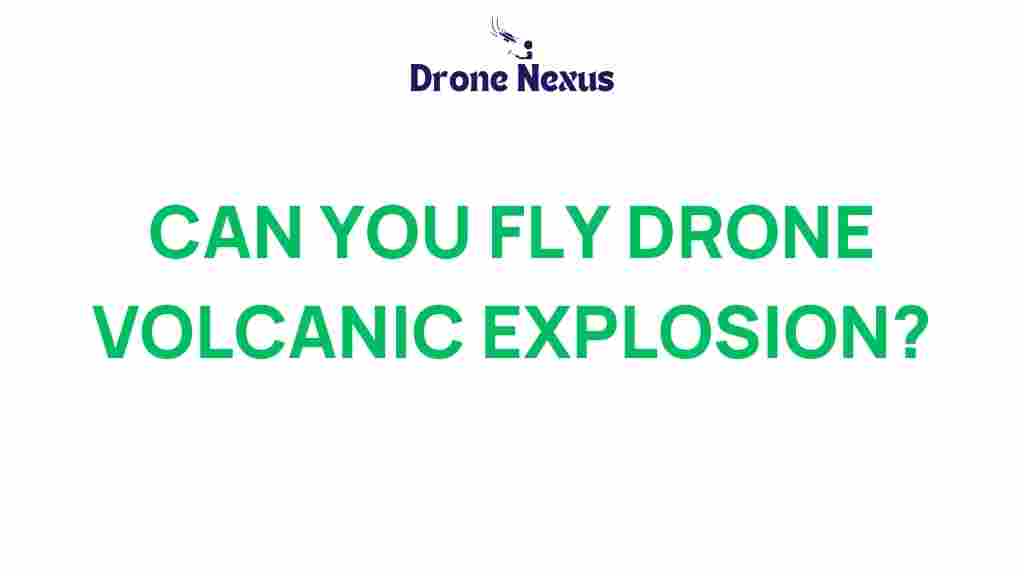Can You Fly a Drone Over a Volcanic Explosion? The Risks and Rewards of Using a Drone
Volcanic eruptions are among nature’s most spectacular and destructive events. As the world becomes more technologically advanced, many enthusiasts and professionals are tempted to capture these breathtaking moments using a drone. However, flying a drone over a volcanic explosion comes with numerous risks and rewards. In this article, we will explore the intricacies of using a drone in such dangerous environments, examining both the potential benefits and the hazards involved.
Understanding the Risks of Flying a Drone Near a Volcano
Before we delve into the rewards of capturing volcanic eruptions with a drone, it’s crucial to understand the inherent risks involved. The following factors contribute to the dangers of operating a drone in volcanic zones:
- Volcanic Ash: One of the most significant risks is the presence of volcanic ash, which can damage a drone’s motors and sensors. Ash can also obscure visibility, making navigation difficult.
- Heat and Gas Emissions: Active volcanoes emit toxic gases such as sulfur dioxide, which can be harmful to both humans and drones. The intense heat can also affect the drone’s performance.
- Unpredictable Eruptions: Volcanic eruptions can occur suddenly, and the drone operator may not be able to react quickly enough to avoid danger.
- Regulatory Restrictions: Many countries have strict regulations that prohibit flying drones in certain areas, especially near active volcanoes. Violating these regulations can lead to legal consequences.
The Rewards of Using a Drone for Volcanic Monitoring
Despite the risks, there are numerous rewards associated with flying a drone over volcanic areas. These benefits include:
- Unique Perspectives: Drones can provide stunning aerial views of eruptions that are impossible to capture from the ground.
- Data Collection: Drones equipped with sensors can gather valuable data on gas emissions, temperature, and ash distribution, contributing to scientific research.
- Safety: Using a drone allows researchers and emergency responders to monitor volcanic activity without putting themselves in harm’s way.
- Environmental Monitoring: Drones can assist in tracking changes in the landscape and vegetation surrounding volcanoes, providing insights into the ecological impacts of eruptions.
Step-by-Step Process for Safely Flying a Drone Over a Volcano
If you decide to operate a drone near a volcanic area, it’s essential to follow a structured approach to ensure safety and compliance. Here’s a step-by-step guide:
Step 1: Research and Understand the Volcano
Before planning your flight, gather as much information as possible about the volcano. Consider the following:
- Current activity level and eruption history
- Geological features and potential hazards
- Weather conditions, including wind and visibility
Step 2: Check for Regulations
Before operating your drone, familiarize yourself with local laws and regulations. Consult official resources to determine:
- Drone flight restrictions in the area
- Permits required for flying near a volcano
- Safety zones established by local authorities
Step 3: Prepare Your Drone
Ensure that your drone is in optimal condition for flight:
- Perform routine maintenance checks on the drone’s motors, batteries, and sensors.
- Consider equipping your drone with filters to protect against ash.
- Charge all batteries fully and bring extra batteries to ensure extended flight time.
Step 4: Plan Your Flight Path
Map out your flight path carefully to avoid hazardous areas. Consider the following:
- Distance from the volcano
- Potential obstacles, such as smoke or ash clouds
- Emergency landing zones, should you need to land quickly
Step 5: Conduct a Test Flight
Before flying over the volcano, conduct a test flight in a safe area. This will help you:
- Familiarize yourself with drone controls
- Test your camera settings for optimal footage
- Ensure all equipment is functioning correctly
Step 6: Execute the Flight
When ready, execute the flight while adhering to the following guidelines:
- Maintain a safe distance from the volcano.
- Monitor real-time data and adjust your flight path as necessary.
- Be prepared to land immediately if conditions worsen.
Troubleshooting Tips for Drone Operation Near Volcanoes
Even with careful planning, issues may arise during drone operation. Here are some troubleshooting tips:
- Loss of Signal: If you lose signal, remain calm. Most drones have a “return to home” feature that will automatically bring it back to you.
- Battery Issues: Monitor your battery level closely. If it drops below a certain threshold, land immediately to prevent crashes.
- Weather Changes: Be aware of changing weather conditions. If you notice significant shifts in wind or visibility, consider aborting the mission.
Conclusion: The Balancing Act of Drone Use Over Volcanoes
Flying a drone over a volcanic explosion is a task that requires careful consideration of both the risks and rewards. While the opportunity to capture breathtaking footage and gather critical data is enticing, the dangers posed by volcanic activity cannot be overlooked. By conducting thorough research, adhering to regulations, and following a structured flight plan, drone operators can safely navigate the complex environment around active volcanoes.
Ultimately, the key to a successful drone operation lies in preparation and respect for nature’s unpredictable power. For more insights on drone usage and safety, visit our resource page.
For further reading on volcanic activity and monitoring techniques, check out this external resource.
With the right approach, the rewards of using a drone in volcanic regions can far outweigh the risks, leading to stunning discoveries and unforgettable experiences.
This article is in the category Safety and created by DroneNexus Team

4 thoughts on “Can You Fly a Drone Over a Volcanic Explosion? The Risks and Rewards”